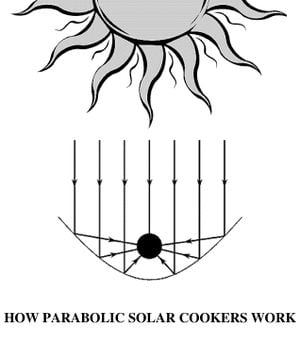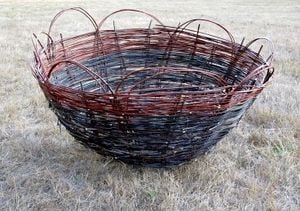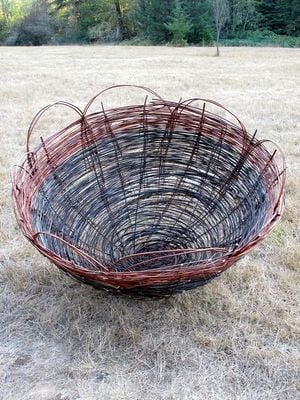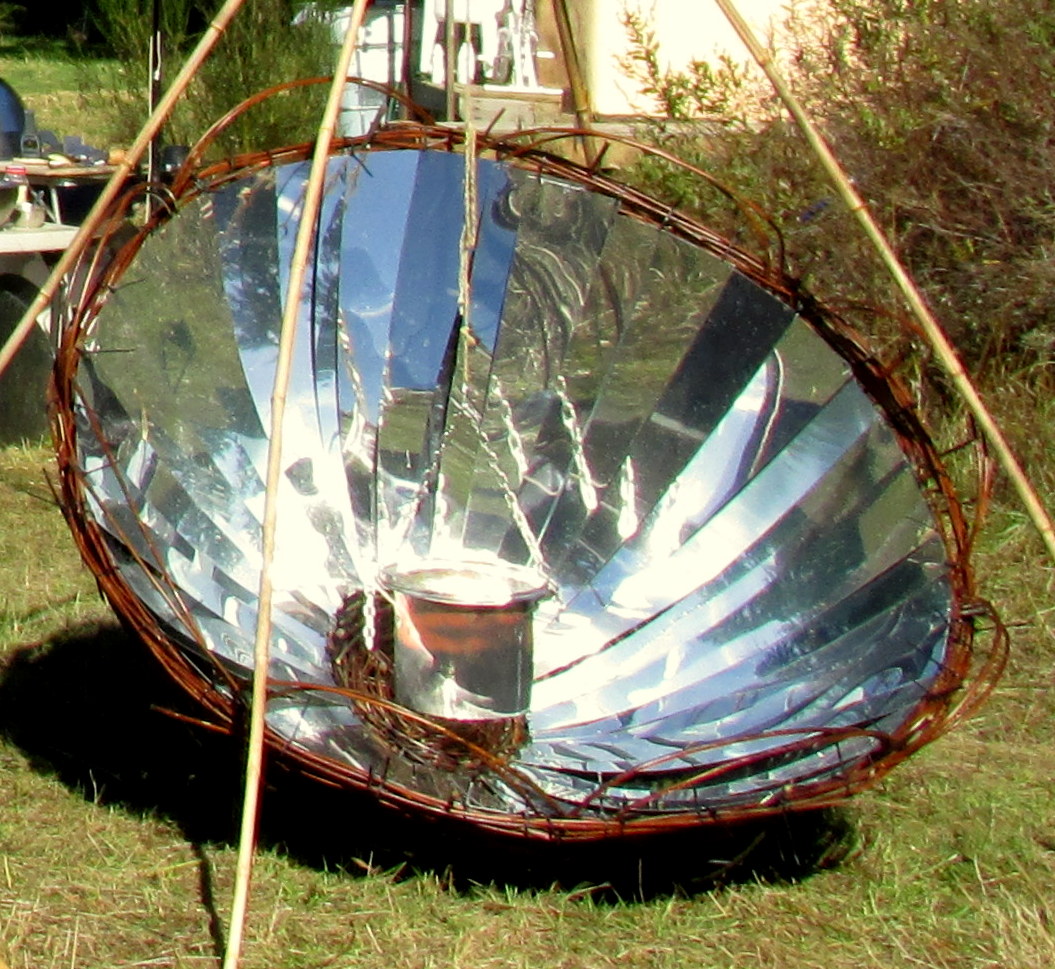No edit summary |
|||
| Line 84: | Line 84: | ||
Select 12 - 16 willow pieces to be original stakes. We used only 6, and got the feedback that it would be stronger with more, but it may be more difficult to begin. | Select 12 - 16 willow pieces to be original stakes. We used only 6, and got the feedback that it would be stronger with more, but it may be more difficult to begin. | ||
Slice with a knife into the middle of half of the stakes, threading the other stakes through all the split ones. You might alternate thicker ends for more symmetry (hence stability) throughout the basket. | Slice with a knife into the middle of half of the stakes [http://www.appropedia.org/File:Slicing_Willow_Stakes.jpeg], threading the other stakes through all the split ones. You might alternate thicker ends for more symmetry (hence stability) throughout the basket. | ||
Take two smaller weavers. Trim to points, and tuck them into the same slot in a split stake, take them around the closest stake, twist them on the other side, and continue crossing over each stake and twisting once on the opposite side. As you do this, work to spread apart the stakes so they fan out from the center. A helper friend might be useful here. When one weaver runs out, overlap a new one in to splice it. Weave in this fashion until you have a circle with a foot diameter, filling in gaps if need be. | Take two smaller weavers. Trim to points, and tuck them into the same slot in a split stake, take them around the closest stake, twist them on the other side, and continue crossing over each stake and twisting once on the opposite side. As you do this, work to spread apart the stakes so they fan out from the center. A helper friend might be useful here. When one weaver runs out, overlap a new one in to splice it. Weave in this fashion until you have a circle with a foot diameter, filling in gaps if need be. | ||
Revision as of 23:46, 26 February 2015
Created by Elizabeth Titus, Bart Orlando, Ell, and Simon H. For The Lost Valley Education and Event Center
Reasons for using a basket as a model for solar cookers

We wish to empower the people of non-industrialized nations, using a method of parabolic solar cooker construction that can employ the skills of traditional basket weavers, using indigenous plant materials. The instructions, (in universal stick figure diagrams)for weaving parabolic baskets should be embossed or etched into the convex surface of solid aluminum or stainless steel parabolic solar cookers of similar size and shape which have been fabricated using salvaged metals) These durable, metallic paraboloids can then be used as examples for educational demonstrations and as templates for weaving parabolic baskets. Mirror finished lids could be provided from food grade stainless steel canned vegetables, airdropped to remote villages and refugee camps and fed to malnourished children, while the rest of the can is used as a cooking pot after being blackened over a cook fire one time. By providing thousands of such templates, millions more can be created by the people who need them most. Two billion women spend most of each day walking many miles from their villages to locate fire wood for their cook fires, which is then carried back in large heavy bundles. This solar cooker can also pasteurize drinking water that would otherwise have to be heated with firewood or carried long distances from safe deep water wells. Parabolic basket solar cookers require 100 times less work than what has traditionally been the norm for more than half of the women of Earth.
Potential uses and applications
Parabolic basket solar cookers can be used for the follow purposes:
Pasteurizing drinking water
Preparing cooked meals
Satellite telecommunication dishes for internet up links, to be used for educational purposes in village schools. (antenna included in airdrop)
How Parabolic Solar Cookers Work

Parabolic solar cookers are powered by LIGHT radiating from an immense hydrogen fueled
thermo-nuclear fusion reaction located in outer-space, 93 million miles from Earth, within the core of a star, we know as our Sun. The word parabolic refers to the precise mathematical curvature of the reflective
mirror which creates a reflecting lens that concentrates direct sunlight to a focal point when aimed directly at
the sun. If a black kettle is filled with water and positioned at that focal point, it will receive and absorb more
sunlight then if it were simply set out in direct sunlight on its own. As the concentrated
sunlight is absorbed by the kettle it is converted into thermal energy which causes the
temperature of the water in the kettle to rise as high as 100o C. In contrast, the light striking the mirror is not absorbed but is
reflected and so the surface of the mirror remains close to ambient temperatures.
(In climates where mid-day ambient temperatures are sub freezing i.e. at high latitudes or at high altitudes, any boiling water that spills from the kettle, down upon the surface of the cold mirror below, will readily freeze.)
In this way, the energy of sunlight can be directly converted into thermal energy for cooking, water pasteurization and for solar flame ignition all around the world.
The mirrored surface can also focus a microwave signal for satellite telecommunications if an antenna is positioned at the focal point in place of the kettle and the parabolic basket, now a satellite dish, is aimed at a communications satellite instead of the sun and used for educational purposes, relaying news, emergency communications and internet uplinks.
Discussion of choices around construction


This basket is meant to inspire indigenous crafters to use their local materials. Willow is a very commonly available weaving material, and relatively easy to use.
We looked at several online resources for weaving and willow treatment.
I used the weaving techniques shared on the site Jon's Bushcraft [1] for the base. Once I got to the sides, I decided to simplify to one weaver to enable the exact dimensions and shape we were going for.
Based on [Bart Orlando's] past experience [(creating a parabolic basket solar cooker)], we created hoops [2] of different diameters to guide accurate construction of our paraboloid.
The Math
Before we began construction, we graphed 3 parabolas; y = .4x2 , y = .5x2, and y = .6x2. Bart chose y = .4x2 because it was just shallow enough to aim by tilting while remaining a deep focus paraboloid. We decided to create one that was 5 feet wide in diameter. I calculated the heights of different diameters accordingly.
For this basket, I created a chart of values corresponding to y = .4x2 for x and y up to 2.5, since our diameter would be 5 feet, so the radius would be 2.5. This happened to be the height as well. We decided to truncate the base at a diameter of 1 foot so it would have a level base (in addition to simplifying the weaving process). This was at a height of .1 foot, so I subtracted .1 foot from all the other heights.
Step by step procedure (best practices)
Soak the straight willow pieces [3] for one day per foot of height [4]. You want mostly 3-6 foot long pieces.
Create hoops [5] from the willow and twine that are an interior diameter of 1, 2, 3, 4, and 5 feet to act as guides to weaving.
Here is a chart of values we generated for height and diameter.
| diameter | height |
|---|---|
| 1 | 0 |
| 2 | about 3 2/3 inches |
| 3 | about 9 2/3 inches |
| 4 | 1 foot 6 inches |
| 5 | 2 feet and 5 inches |
This site was the main inspiration for technique: [[6]]
Select 12 - 16 willow pieces to be original stakes. We used only 6, and got the feedback that it would be stronger with more, but it may be more difficult to begin.
Slice with a knife into the middle of half of the stakes [7], threading the other stakes through all the split ones. You might alternate thicker ends for more symmetry (hence stability) throughout the basket.
Take two smaller weavers. Trim to points, and tuck them into the same slot in a split stake, take them around the closest stake, twist them on the other side, and continue crossing over each stake and twisting once on the opposite side. As you do this, work to spread apart the stakes so they fan out from the center. A helper friend might be useful here. When one weaver runs out, overlap a new one in to splice it. Weave in this fashion until you have a circle with a foot diameter, filling in gaps if need be.
Once you have your circle base, notice how strong, flexible, and long your stakes are at the circumference. Select some new stakes to trim to a point and insert to the right of selected stakes you want to replace before you continue. Any replaced stake should be cut off at the edge of the circle.
Now you will create the rim of the bottom of the basket. Warm up the base of the stakes by rubbing them and bending them gently, then bend one to the left, behind two stakes and then straight up. Do this with each stake in succession, to the left, tying stakes upright to get them out of the way. A friend can be helpful here, too. The last two you will need to tuck in and up, so the pattern continues all the way around, and creates a self-contained rim.
Select some long, thin, flexible weavers. Trim the small end so you can tuck it away in the weave, and weave once around the base, in and out each stake.
Stake the 2 foot hoop up about 4.5 inches off the ground. I added a bit of height to account for the basket bottom. You might use solid willow pieces, sharpened at both ends in order to be driven into the ground and stuck into the hoop.
Stake the basket to the ground in the center of the two foot hoop. Tie the stakes to the hoop, letting them spiral a bit but trying to get the center stable. Weave in and out with one weaver at a time until you reach the hoop.
Set up the 3 foot hoop so it is about 10.5 inches off the ground. Set the basket up inside it, without the previous hoop, and weave until you reach that one. Continue with the 4 foot hoop, which is about 1 foot and 7 inches high, and the 5 foot hoop, which is 2 feet and 6 inches high. You might decide to use other wood for stakes, sharpening the end to drive into the ground and adding a nail to the top with its head clipped off so it can attach to the hoops.
As you weave new ones in, you might use them to stabilize previous weavers by weaving in and out toward the base, then turning to weave sideways. Push down your weavers as you go and work to tuck away ends neatly for more stability. When you are done, trim ends that stick out too much. You also might add new stakes in as you go by pushing them into the weave, and preferably base.
Once you reach the top, leave some of the stakes sticking out to hold the weavers, trimming them up. The top would be easy to pull off, so select some good pieces to make handles that also hold the top on. Shave each end to flat wedges, and for extra grip carve several upward facing notches on each side. Warm up the willow by gentle bending and rubbing for warmth. Bend each piece and insert ends at a chosen distance apart around the top. Place two together for stronger handles. Be conscious of how much of a gap you are creating; too big a space will make it easier to accidentally pull them out.
Debrief (what worked , what did not)
Willow is much easier to work with when properly soaked. Harvest in the winter, let sit and dry for many months, then soak for a day per foot of length. Take it out to mellow a day before you use it. Try to use it for the base within 4 days of soaking. This is the trickiest part, with the tightest turns. Once you get up to the 2 or 3 foot diameter hoop, the turns are much more forgiving and you can be less selective about the state your willow is in. If your willow is breaking or creasing, check your soaking methods and maybe spend more time warming it up where you want it to bend.
We tried a lot of methods for measuring the dimensions of the basket as we worked, including trying to make an internal guide with a stick as the axis and strings attached, an external hanging basket with the hoops tied together in order to cradle the basket, and measuring and re-measuring as we went. The best technique by the end seemed to be staking up one hoop at a time, and centering then staking the basket inside. I did a lot of number crunching to try to calculate other relationships between points and diameters, but the simple height:diameter relationship was definitely the most helpful.
Staking worked okay with sharpened willow stakes, but we needed something taller and more uniform for the higher hoops.
We decided that storing the basket upside down might be the best to maintain integrity.
